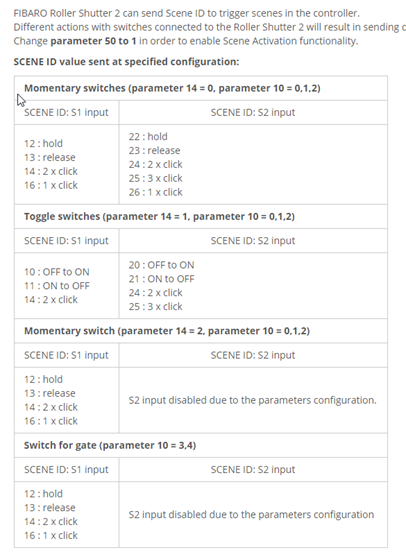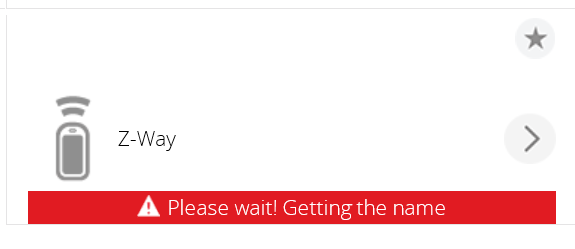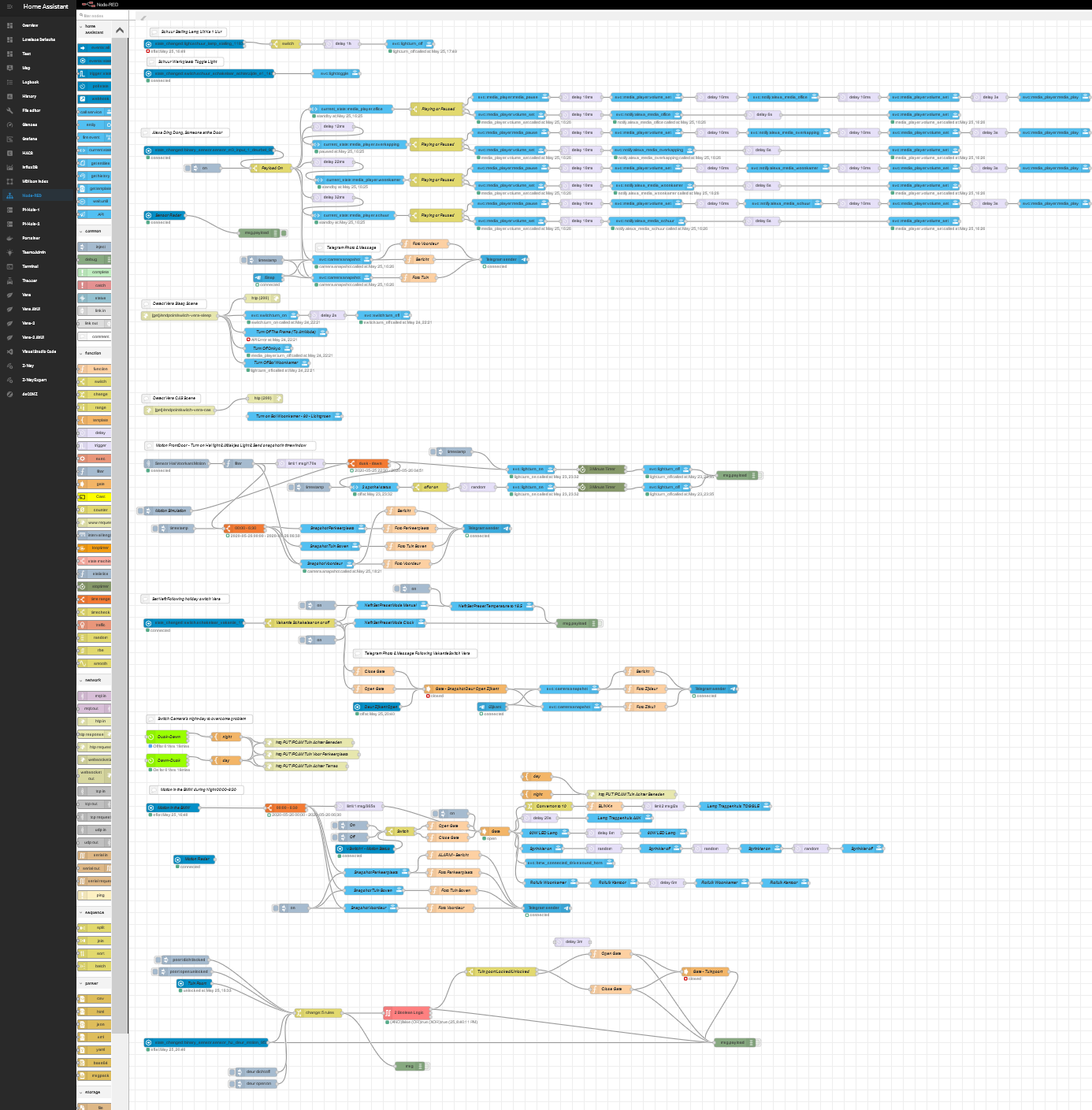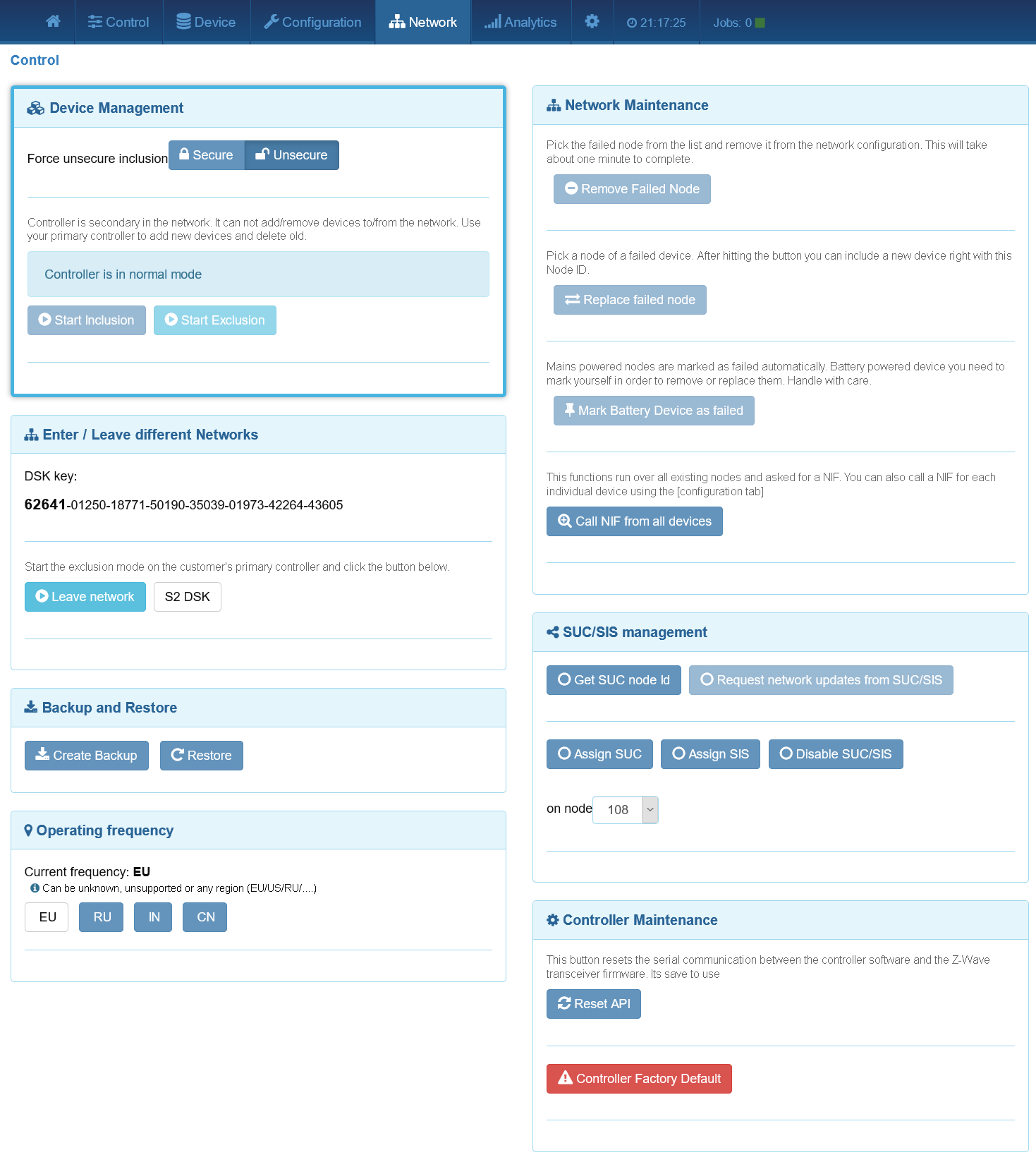z-way-server ubuntu install
-
Rafael, you are right... I don't know z-wave well enough. at least the low level details. I am just a user that wants a "stable" network without too much trouble. And yes to achieve that I realize I need to get familiar with the terminology and techniques.
For that vera inclusion part. I did exactly what was on page 1 of https://smarthome.community/topic/63/adding-z-way-as-secondary-controller-to-vera-zwave-network/38 just like last time. That's pretty straightforward and I cannot imagine what could be wrong there... You write " You seem to have set vera in inclusion mode correctly but for z-way, you need to put it in learning mode under network/control/join network." and with that you mean below though?
-
Ok, I update the firmware of the stick a few times.
Now trying to include in Vera... but got stuck after many minutes:

I do get the fact that when all is well this product should be awesome. But having spent so many times (and money) and took so many hurdles to get things going, this is where my journey ends and I would like to thank you all kindly for all help and effort. I really hope one day z-wave will see the light but I think this way, it will only get darker. Don't get me wrong, there is always a small group of enthusiasts to which I also wanted to belong but with SO MANY TROUBLES, User side (mine/me) or technology side this is too many steps too far for me.
Thanks again and it was a very pleasant view to have my vera devices in z-way for a very little while (around 15 minutes) about 2 weeks ago.
A BIG THANK YOU AGAIN!
-
You got an error because you tried to exclude a device from z-way when the exclusion process needs to start from the master controller. You need to set the vera in exclusion mode and then go to z-way to "leave the network".
The way you did it, the vera has not configured the z-way controller yet. It just included it. Because it is an unknown device, the vera buggy autoconfiguration will not work. You have to disable auto configuration on the vera to get rid of that error.
All z-way does when you hit the leaving the network button, is to wakeup the z-way's zwave chip. It is expecting the master controller to be in exclude mode. If it isn't it will fail and this is by design.When adding a secondary z-wave controller, you have to think of it as just an additional device on the network. That's all it is. Everything you did using the vera remains the same. Nothing has changed. Configuring devices, including, excluding... all the same. You would be doing the same thing if you included another vera or any other controller or even any other device and needed to exclude it.
Understanding how zwave works under the hood is not very complicated and essential but most of your problems are caused by vera's incomplete implementation of z-wave network control making things very obscure.
If you had started from clean from z-way, you would have a much simpler system. If you want to run a dual controller, setup, you will need to learn how the z-wave topology and commands work at the most basic level. If you want a clean and simple z-wave system, you are better off getting rid of the vera and forget everything about it. -
You got an error because you tried to exclude a device from z-way when the exclusion process needs to start from the master controller. You need to set the vera in exclusion mode and then go to z-way to "leave the network".
The way you did it, the vera has not configured the z-way controller yet. It just included it. Because it is an unknown device, the vera buggy autoconfiguration will not work. You have to disable auto configuration on the vera to get rid of that error.
All z-way does when you hit the leaving the network button, is to wakeup the z-way's zwave chip. It is expecting the master controller to be in exclude mode. If it isn't it will fail and this is by design.When adding a secondary z-wave controller, you have to think of it as just an additional device on the network. That's all it is. Everything you did using the vera remains the same. Nothing has changed. Configuring devices, including, excluding... all the same. You would be doing the same thing if you included another vera or any other controller or even any other device and needed to exclude it.
Understanding how zwave works under the hood is not very complicated and essential but most of your problems are caused by vera's incomplete implementation of z-wave network control making things very obscure.
If you had started from clean from z-way, you would have a much simpler system. If you want to run a dual controller, setup, you will need to learn how the z-wave topology and commands work at the most basic level. If you want a clean and simple z-wave system, you are better off getting rid of the vera and forget everything about it.@rafale77 said in z-way-server ubuntu install:
If you want a clean and simple z-wave system, you are better off getting rid of the vera and forget everything about it.I want! But there is a way between Vera <--> homeassitant and Z-way <--> homeassistant. Well 2 ways. 1 is migrating and 2, the most important one, there is nothing for z-way in home assistant, the MQTT plugin is buggy, installation is not straight forward etc...
-
You got an error because you tried to exclude a device from z-way when the exclusion process needs to start from the master controller. You need to set the vera in exclusion mode and then go to z-way to "leave the network".
The way you did it, the vera has not configured the z-way controller yet. It just included it. Because it is an unknown device, the vera buggy autoconfiguration will not work. You have to disable auto configuration on the vera to get rid of that error.
All z-way does when you hit the leaving the network button, is to wakeup the z-way's zwave chip. It is expecting the master controller to be in exclude mode. If it isn't it will fail and this is by design.When adding a secondary z-wave controller, you have to think of it as just an additional device on the network. That's all it is. Everything you did using the vera remains the same. Nothing has changed. Configuring devices, including, excluding... all the same. You would be doing the same thing if you included another vera or any other controller or even any other device and needed to exclude it.
Understanding how zwave works under the hood is not very complicated and essential but most of your problems are caused by vera's incomplete implementation of z-wave network control making things very obscure.
If you had started from clean from z-way, you would have a much simpler system. If you want to run a dual controller, setup, you will need to learn how the z-wave topology and commands work at the most basic level. If you want a clean and simple z-wave system, you are better off getting rid of the vera and forget everything about it.@rafale77 said in z-way-server ubuntu install:
You got an error because you tried to exclude a device from z-way when the exclusion process needs to start from the master controller. You need to set the vera in exclusion mode and then go to z-way to "leave the network".
The way you did it, the vera has not configured the z-way controller yet. It just included it. Because it is an unknown device, the vera buggy autoconfiguration will not work. You have to disable auto configuration on the vera to get rid of that error.
All z-way does when you hit the leaving the network button, is to wakeup the z-way's zwave chip. It is expecting the master controller to be in exclude mode. If it isn't it will fail and this is by design.I did not try to exclude anything in z-way. I did that excatly: set vera in exclusion and "leave network" in z-way, that works well! Only the other way around doesn't, the inclusion in the network (Include into network). In the screenshot you may see (Re-)inclusion started but that shows also when I did "include into network".
-
I see. Sorry if I misunderstood.
The only time I have seen this is when the vera is in its typical crash hang up mode. The vera has started to include a device and its command queue got into wait mode therefore never completing the inclusion. In that case, I would repeat it until it works. It is a vera problem, no different from all the problems including secure class devices the vera has been struggling with.
Again, when you do it this way, z-way is no more than an additional device on the vera network and has all the same problems the vera has with secure class devices. -
I see. Sorry if I misunderstood.
The only time I have seen this is when the vera is in its typical crash hang up mode. The vera has started to include a device and its command queue got into wait mode therefore never completing the inclusion. In that case, I would repeat it until it works. It is a vera problem, no different from all the problems including secure class devices the vera has been struggling with.
Again, when you do it this way, z-way is no more than an additional device on the vera network and has all the same problems the vera has with secure class devices.@rafale77 said in z-way-server ubuntu install:
I see. Sorry if I misunderstood.
The only time I have seen this is when the vera is in its typical crash hang up mode. The vera has started to include a device and its command queue got into wait mode therefore never completing the inclusion. In that case, I would repeat it until it works. It is a vera problem, no different from all the problems including secure class devices the vera has been struggling with.
Again, when you do it this way, z-way is no more than an additional device on the vera network and has all the same problems the vera has with secure class devices.This sounds logical, but this would be the 5th time then... I am running out of patience...
-
@rafale77 said in z-way-server ubuntu install:
I see. Sorry if I misunderstood.
The only time I have seen this is when the vera is in its typical crash hang up mode. The vera has started to include a device and its command queue got into wait mode therefore never completing the inclusion. In that case, I would repeat it until it works. It is a vera problem, no different from all the problems including secure class devices the vera has been struggling with.
Again, when you do it this way, z-way is no more than an additional device on the vera network and has all the same problems the vera has with secure class devices.This sounds logical, but this would be the 5th time then... I am running out of patience...
Yep, blame vera... I took me over 50 attempts and 3 hours on the phone with support to pair a Yale lock. It also took me hundreds of attempts to pair a vision ZP3111-5 securely. You can probably see in the old place my sharing of experience about secure class inclusion success probability, something that blacey mitigated by rebooting the vera just before the inclusion attempt. This varies a lot with what you have going on in your zwave network. The vera takes patience. Something I ran out of which triggered the migration.
I also know that you are committed to home assistant as your automation controller. Sorry, I don't have a good answer for it. As you already know, I vastly prefer openLuup for two reasons: 1. I prefer lua 2. Home assistant automation engine is not as powerful and would require node-red to match openLuup's capability as a front end. At that point, why not just run openLuup+z-way and use home assistant for what it is good at: an integration bridge.
-
Yep, blame vera... I took me over 50 attempts and 3 hours on the phone with support to pair a Yale lock. It also took me hundreds of attempts to pair a vision ZP3111-5 securely. You can probably see in the old place my sharing of experience about secure class inclusion success probability, something that blacey mitigated by rebooting the vera just before the inclusion attempt. This varies a lot with what you have going on in your zwave network. The vera takes patience. Something I ran out of which triggered the migration.
I also know that you are committed to home assistant as your automation controller. Sorry, I don't have a good answer for it. As you already know, I vastly prefer openLuup for two reasons: 1. I prefer lua 2. Home assistant automation engine is not as powerful and would require node-red to match openLuup's capability as a front end. At that point, why not just run openLuup+z-way and use home assistant for what it is good at: an integration bridge.
@rafale77 Home-assistant is currently the new star in my network... where Vera was just a few weeks ago homeassistant is now... and truly EVERTYTHING IS IN and it works 95-100 time directly... the only PROPER thing missing is a GOOD Z-wave bridge in which Vera as such doesn't do a very bad job at all, weren't it the fact that the z-wave part and device support for that is just not as stable as I want... But on the other hand, the openzwave, zwave2mqtt, QT openzwave (the new beast of hass) and all other "openzwave" falls away with the z-way potential (I have seen)... but the latter is not integrated in homeassistant... so I and completely frustrated here... BTW my entire house is already noded-red... SO SIMPLE!
-
If this (node-red+homeassistant) is your preferred approach, I would recommend moving to hubitat, there is a custom component for it on home-assistant. It is a much better implementation of zwave and zigbee than vera. Otherwise you will have to wait for the z-way component (which is in the works?). From all my testing, vera has become pretty much the worse zwave implementation available. I am sure there are worse ones but I have not tried them. openzwave is a little better, hubitat is much better and homeseer and z-way are top notch.
-
Is hubitat so new? https://hubitat.com/products It's unbuyable


-
I had one, and only gave it away after migrating to z-way as I saw it as a backup solution.
For device support, it does not support S2 unlike z-way and homeseer. It uses a mostly community driven device driver development which is shared with SmartThings so it truly supports every device (except S2 ones) unlike the vera and ezlo which rely on a library and forced preset device list. The one controller which really supports everything zwave is Z-way.
It also doesn't really support being a secondary controller and has some quirks when setup that way. I know, I tried...It is not new at all, it is actually a couple of years old. I have had mine for at least 2 years.
As for the message on the vera about waiting for the name, it is the vera attempting to configure the z-way controller. You can ignore it by setting the z-way device in vera to no auto configure. It is normal by vera standard. What you should see though is the vera device list in z-way.
When using two controllers, you should also set the primary as SUC/SIS. (should be device 1, the vera). That way you can use z-way to include devices and you can also run the "request network updates from SUC/SIS" if z-way did not get the device list from the vera.The inclusion process for zwave goes like this (I posted a graph somewhere on this forum too):
controller set in include mode -> client device wakeup -> controller adds device to its network list and sends HomeID and DeviceID -> client device gets both IDs, saves them and send ack frame back -> controller sends node info frame (NIF) to device -> client responds with list of supported command classes -> If security is supported controller sends security key exchange frame -> Then device updates neighbor nodes and sends its neighbor list to controller->after it is complete if client is controller, it will send a get network info to controller -> controller responds with list of devices.The vera tends to fail at sending security keys as it hangs there easily so everything behind it will not happen.
You can manually force everything to happen except for the security key exchange which... I actually managed to do it by manually inserting the key in the z-way controller and bypass this entire process. -
Thank you, my z-way adventure is over. The Virtual Machine is shutdown.
I will monitor communication around it and if there is a supported home assistant integration I will give it another try.
I just added another zigbee device in my deconz (container in homeassistant) and instantly works... Just want to say, that if z-wave wants to keep seeing the light it should be made stable, by whoever wants to do so (vera, z-way, openzwave)...
Thanks again!
-
Curl trouble:
x@x:/usr/lib/x86_64-linux-gnu$ sudo apt-get -y install libcurl3 Reading package lists... Done Building dependency tree Reading state information... Done Package libcurl3 is not available, but is referred to by another package. This may mean that the package is missing, has been obsoleted, or is only available from another source However the following packages replace it: libcurl4 E: Package 'libcurl3' has no installation candidate..?
















